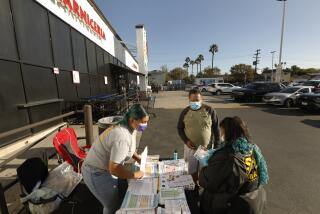This Is Only a Test of Bioterrorism Response
- Share via
A daylong drill today to examine Los Angeles County’s response to a biological weapons attack won’t test critical skills that could determine how many people live or die.
The exercise, planned by the county’s emergency management office, was designed to gauge how well hospitals execute their disaster plans. But the drill was planned well before the anthrax outbreaks, and, as a result, it won’t study how quickly doctors and county disease sleuths can identify lethal bugs and treat potential victims before they become sick.
Instead, the drill assumes that the biological weapon has already been identified--when, in fact, the process of identification could prove to be the most difficult challenge posed by an actual disaster.
“In retrospect, if we were planning it again, we might do things somewhat differently,” said Virginia Hastings, director of the county’s Emergency Medical Services Agency. “You can’t change these things on a dime. They’re too complicated.”
Also, the drill will not look at how well county officials coordinate with the FBI and Centers for Disease Control and Prevention, which have taken the lead in the response to the recent anthrax attacks.
“We’re not going to learn much from this drill,” said Jim Lott, executive vice president of the Healthcare Assn. of Southern California. “We’re simply testing the responsiveness of our communications systems. We need to do that every year to stay sharp and to find out if we have any glitches.”
Organizers want answers to basic questions: Do radios and computers work? Do hospitals confine infectious patients in special isolation rooms or keep them with other patients? How well does the county share information with hospitals and nonprofit agencies to avoid panic and send supplies where they are needed?
The drill is based on a made-up scenario. It takes place six days after the release of plague bacteria in a fictitious setting: the Beachside Performing Arts Center in Harbor City. According to the script, the plague sickens 1,000 people, who then infect 500 others.
Pneumonic plague is a highly infectious disease that is fatal in nearly all cases if left untreated. People become ill one to six days after being exposed. Initial symptoms include fever with cough, difficulty breathing, bloody or watery saliva or mucus, nausea, abdominal pain and diarrhea. The infection then takes the form of severe, rapidly progressing pneumonia.
Unlike other drills, which have used participants with fake injuries, today’s will largely be a tabletop exercise, meaning that officials will sort through problems on computers and on paper.
Los Angeles County officials are worried that some people might become alarmed if they hear about the drill on the radio or television, especially after the anthrax attacks on the East Coast. Their worst nightmare is a repeat of the mass hysteria generated by the 1938 radio broadcast of Orson Welles’ fictional “War of the Worlds,” which involved a hostile alien invasion in which spacecraft landed in Grover’s Mill, N.J.
“We want the public to know that this is not anything new,” said Constance Perett, administrator of the county’s Office of Emergency Management. “There is nothing sinister about this exercise.”
To prepare for the drill, county officials have told participants key details that they would not have in an actual emergency. Hospitals have even been given evaluation forms in advance, which ask if they followed important procedures.
Participants say the drill is worthwhile because it allows hospitals to examine their internal disaster plans and make changes. But the drill gives the participants an unrealistic advantage, providing them with with important information they wouldn’t have before an actual attack.
“Obviously if you tell people in advance what you’re going to do and give them lots of details, then you’re taking away the elements of surprise,” said Dr. Milton Louie, chairman of the infection control committee at Glendale Memorial Hospital.
County officials say the drill can’t be totally realistic because it must involve dozens of cities and all 81 hospitals in the county. In an actual event, the plague would probably be confined to a limited geographic area and only a handful of hospitals would receive infected patients.
Even if today’s drill goes off without a hitch, it won’t answer a basic question on the public’s mind: Is the county prepared to handle a bioterrorist attack?
“The drills that we’ve been doing up to now are inadequate for a post [Sept. 11] event,” Lott said. “I don’t think anyone would argue that point.”
More to Read
Sign up for Essential California
The most important California stories and recommendations in your inbox every morning.
You may occasionally receive promotional content from the Los Angeles Times.













